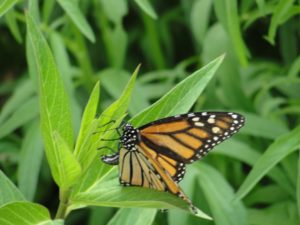Somewhere between 75% and 95% of all flowering plants on the earth need the help of pollinators in order to reproduce and to produce seeds and fruit. If we lose our pollinators it will have a devastating effect on all animals including humans. Unfortunately, the populations of pollinators are dramatically decreasing. Some of the reasons for this are attributed to habitat loss and fragmentation, the use of pesticides, disease, and changes in climate. Adding native plants to your yard and eliminating or greatly reducing the use of pesticides is a great way to help protect our pollinators and planet.
Butterflies
 The monarch butterfly is one of the most familiar and well studied butterflies and is famous for its amazing migration from the United States and Canada to California and Mexico. Monarch Butterflies are not only beautiful but they pollinate many types of wildflowers and are an important food source for birds, small animals, and other insects.
The monarch butterfly is one of the most familiar and well studied butterflies and is famous for its amazing migration from the United States and Canada to California and Mexico. Monarch Butterflies are not only beautiful but they pollinate many types of wildflowers and are an important food source for birds, small animals, and other insects.
Below are some websites to learn more about the monarch butterfly:
DuPage Monarch Project
Illinois Monarch Project
Monarch Watch
U.S. Forest Service Monarch Butterfly Home
The number of monarchs has greatly diminished over the past 20 years. On December 15, 2020, the U.S. Fish and Wildlife Service announced that listing the monarch as endangered or threatened under the Endangered Species Act is warranted, but precluded by higher priority listing actions. Here is the a link to the report.
What can you do to help the monarchs? Monarchs need a variety of nectaring plants to support their adult life. In addition they need milkweed plants because milkweed is the only plant that they will lay their eggs on and that the caterpillars will eat. Pictured below is a monarch laying an egg on a marsh milkweed plant (Asclepia incarnata) in a DuPage yard:
By planting milkweed you can do something yourself to help nature and the monarchs. What you do in your yard matters. Join the DuPage Monarch Project and the Illinois Monarch Project and take the pledge to plant milkweed in your yard or organization!
Here is a resource for creating a monarch habitat:
Creating Monarch Habitat in Your Midwestern Garden Field Museum Guide
Here are some recorded webinars on monarchs:
Magnificent Monarchs
Xerces Classroom: The Natural History of Monarch Butterflies
An Intimate Look at the Life Cycle of the Monarch Butterfly
Grow Native! Webinar: Monarch Population Trends, Conservation & Climate Change with Dr. Chip Taylor
Illinois has many other beautiful and interesting butterflies and they are also very important to our ecosystem. Many of the steps that we take to help monarchs will also protect our other butterflies. Here are some online resources to learn more about some of the other butterflies in our state:
Common Butterflies of the Chicago Region – Specimen and Live Photos Illinois Field Museum Guide
Butterflies of Fermilab
Illinois Butterflies – Common Species iNaturalist Guide
Butterflies Handout from The Conservation Foundation
ButterflyIdentification.org Illinois Butterflies
Backyards for Butterflies
Here are some great books on butterflies:
Attracting Native Pollinators: The Xerces Society Guide, Protecting North America’s Bees & Butterflies by the Xerces Society. Storey Publishing, LLC; 384 pages
Butterflies of Illinois: A Field Guide – by Michael Jeffords, Susan Post, James R. Wiker. Illinois Natural History Survey; (2019); 264 pages
Caterpillars of Eastern North America: A Guide to Identification and Natural History – by David L. Wagner. Princeton University Press; (2005); 512 pages
Field Guide to Butterflies of Illinois – by John K. Bouseman. Illinois Natural History Survey; (2001) 264 pages
Field Guide to the Skipper Butterflies of Illinois by John K. Bouseman, James G. Sternburg, James R. Wiker. Illinois Natural History Survey; 200 pages
Kaufman Field Guide to Butterflies of North America (Kaufman Focus Guides) – by Jim P. Brock, Kenn Kaufman. Houghton Mifflin Harcourt (2006); 384 pages
Peterson First Guide to Caterpillars of North America – by Amy Bartlett Wright. Houghton Mifflin Harcourt; (1993); 128 pages
Stokes Butterfly Book: The Complete Guide to Butterfly Gardening, Identification, and Behavior by Donald & Lillian Stokes & Ernest Williams. Little, Brown and Company; (1991) 96 pages
Bees
We have all heard about honeybees and how their populations are diminishing. There is only one honeybee species in the United States and this species is an introduced species from Europe. North America has around 3,600 species of native bees and these bees are actually much better and important pollinators than honeybees.
Here are some online resources on bees:
Bee Basics An Introduction to Our Native Bees – Free online book from the USDA Forest Service about our native bees which is well illustrated for easy learning!
Buying Bee-Safe Plants Fact Sheet from Xerces Society
Pollinators and Pesticides – A free e-book that discusses neonicotinoids and their effects from the Center For Food Safety
Bumble Bee Watch – Bumble Bee Watch is a collaborative effort to track and conserve North America’s bumble bees.
US Fish & Wildlife Service’s Rusty Patched Bumble Bee Midwest Plant Guide – Find out what plants help support the endangered Rusty Patched Bumble Bee.
Here are some recorded webinars on native bees:
Bees at Home: the Natural History of Bumble Bee Nesting
Bryan Danforth: The Solitary Bees
Native Bumble Bees in Your Own Backyard: Reflections of a Backyard Bee-chaser
Pollinator Conservation
Here is a great online resource to learn more about pollinator conservation:
Xerces Society Pollinator Conservation Program
